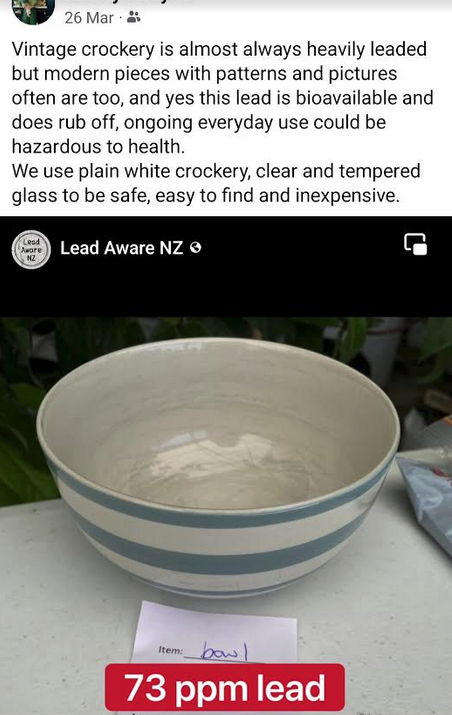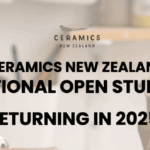Your cart is currently empty!
“Is it food safe?”
By Locke Jean-Luc Unhold
This is one of the most common questions I see asked about glaze recipes. Unfortunately, like many things in ceramics, the answer is usually, “It depends.”
It depends on how thick or thin you apply it. It depends on your firing temperature. It depends if you have to substitute materials. It really depends. But most New Zealand-made pottery is perfectly safe.
The topic of food safety is complex, hotly debated, and often misunderstood. There is a large amount of chemophobia and mythology at play in the space around glaze materials. Often people will ascribe toxicity to a fired glaze based on the raw ingredients of the glaze, neglecting that once fired into a stable glass matrix those toxicity problems have been rendered inert.
Take barium carbonate as a prime example. Many people refuse to work with it because they have heard it is “toxic” – but what does that actually mean?
Barium carbonate interacts with stomach acid and can cause severe gastrointestinal problems and even death (US Department of Health and Human Services – Agency for Toxic Substances and Disease Registry, 2007). So yes, barium carbonate is very toxic and we should take utmost care when using this material. However, once it is melted into a glaze, the form barium takes changes drastically. It is no longer barium carbonate as the barium has bonded with the other elements in the glaze to create something different. Barium carbonate – like most glaze materials – is much much more toxic and problematic for us, the ceramicists, than it is for those using the items we produce.
So let’s talk about the big elemental elephant in the room – lead. On TikTok lately, there’s been many videos of people using lead-testing pens on objects around the home, including ceramic surfaces. The problem is that these testing pens are not designed for this use. They are designed to test for lead present in paint specifically, and many have been found to produce false-positives (Are DIY Lead Paint Tests Accurate?, 2020). The chemical makeup of paint and glaze are very different, and this is readily apparent when we consider the way paintings degrade over time (Iscen et al., 2021) versus ceramics.

As ceramicists, we know that glaze is essentially a thin layer of glass on the outside of our pots. Glaze is not soluble in water once fired, just like how glass isn’t soluble. Paints can be damaged by water and light. Of course, over a very very long time, our glazes can be eroded by water just like rocks on the beach. But think about museum preservation: paintings must often be housed in temperature and pressure sensitive environments and archivists must do regular work to ensure that paintings remain as vibrant and detailed as they were when they were created. Ceramic objects on the other hand last much longer without as much intensive care and restoration required.
All that said, of course there are ceramics with lead in their glaze. This mostly includes vintage pottery, but even modern mass-manufactured ceramics utilise some amount of lead in their glazes. However, if the glaze is chemically stable then it’s not actually as big of a deal as you might expect due to glaze durability.
A durable glaze is one that will not be breaking down and leaching its materials into the food or liquid it holds. Research has shown that glazes with a flux ratio of 0.3:0.7 R₂O:RO (alkaline metals to alkaline earth materials) are the most durable against both acidic and alkaline based attacks against glass (Katz, 2012). This is true regardless of temperature, although as Katz states in his NCECA 2012 article, the addition of boron is required for lower temperatures both for durability and to achieve the desired melt. While it might not be true that a random handmade cup from the 1920’s has a stable flux ratio, it behooves modern ceramic manufacturers to create durable glazes.
Keep in mind though that currently, nearly all factory-produced ceramics being sold in Aotearoa are manufactured overseas. If you suspect that the crockery you bought from Kmart or Briscoes has lead in it, boycotting handcrafted New Zealand pottery isn’t going to help solve the problem. On top of that, commercially-sold pre-mixed glazes marketed to ceramicists do not tell you what their contents are. Many will state “Lead-Free” on their labels, but may have no additional information about their chemical makeup. We would hope that a company selling pre-mixed glazes has done enough testing on their own wares to ensure they are stable, but we can’t be certain. I always advise people that if they want to be 100% certain of their work, mixing their own glazes is the way to be sure.
What this brings us back to is the fact that our glaze materials – even ones as bad as lead – are more toxic to us, the people mixing up and applying raw glaze to the work, than they are for those using our finished pieces. You are much more likely to have glaze material residue on your hands, not wash them well enough, and then eat a sandwich and accidentally consume those materials than you are of drinking out of a cup leaching toxic levels of materials.
Even heavy metals like copper are not likely to cause many issues for our customers. Some testing has concluded that even if a glaze with 5% copper carbonate in it managed to leach 100% of the copper into the water of a cup, you would have to drink so much water out of the cup that you would first die of hyponatremia (poisoning from drinking too much water) before you would get the effects of copper toxicity (Berg & Katz, 2018). It’s just not going to happen!
The main thing you should take away from this article as a ceramicist is to be vigilant in your health and safety in your glazing areas. Ensure there is proper ventilation, that you are using the appropriate dust respirator, and that you wash your hands thoroughly when you’re done. The main thing you should take away from this article as a user of ceramic objects is to support your local potters, as they will try their best for you.
Locke Jean-Luc Unhold (he/him/his) is the technical teacher and Glaze Technology lecturer at the Dunedin School of Art. He has both Level 5 and Level 6 NZDAD Ceramics diplomas and is currently undertaking postgraduate study at the Dunedin School of Art.
References
Are DIY Lead Paint Tests Accurate? (2020, October 15). DCM Environmental Testing Co. Retrieved April 26, 2024, from https://www.dcmenvironmentaltesting.com/are-diy-lead-paint-tests-accurate/
Berg, P., & Katz, M. (2018, December 3). Copper Leaching and Glaze Durability. Glazy. Retrieved April 28, 2024, from https://help.glazy.org/downloads/pdf/031218-peter_berg-final_draft.pdf
Iscen, A., Forero-Martinez, N. C., Valsson, O., & Kremer, K. (2021, September 15). Acrylic Paints: An Atomistic View of Polymer Structure and Effects of Environmental Pollutants. Journal of Physical Chemistry B, (125), 10854-10865. 10.1021/acs.jpcb.1c05188
Katz, M. (2012). Mid-Temperature Glaze Science. 2012 NCECA Journal, 58 – 60. https://issuu.com/nceca/docs/2012journal
US Department of Health and Human Services – Agency for Toxic Substances and Disease Registry. (2007, August). HEALTH EFFECTS – Toxicological Profile for Barium and Barium Compounds. NCBI. Retrieved April 26, 2024, from https://www.ncbi.nlm.nih.gov/books/NBK598777/

